Table of Contents
- Introduction
- Editor’s Choice
- What is Medical Technology and Innovation?
- Adoption of Digital Health and Telemedicine: Key Statistics and Market Projections
- Artificial Intelligence (AI) in Healthcare
- Advancements in Medical Technology: Transforming Healthcare and Precision Medicine
- Adoption of Wearable Medical Devices
- Robotics and Automation in Healthcare
- Innovations in 3D Bioprinting
- Medical Technology and Innovation – Biotechnology Innovations
- Medical Technology and Innovation: Key Statistics in Top Countries
- Recent Developments
- Key Takeaways
- FAQs
Introduction
Medical Technology and Innovation Statistics: In recent years, there has been a remarkable acceleration in the pace of medical technology advancements. These are driven by factors such as technological advancements, increased funding for research and development, and the growing demand for innovative solutions to address healthcare challenges.
These advancements have the potential to revolutionize various aspects of healthcare delivery, from diagnostics and treatment to patient monitoring and disease prevention.

Editor’s Choice
- The global medical technology market was valued at $456.9 billion in 2020 and is projected to reach $695.5 billion by 2027.
- Growing at a compound annual growth rate (CAGR) of 6.1% during the forecast period.
- The adoption of telemedicine services increased significantly during the COVID-19 pandemic. In the United States.
- Telehealth visits accounted for approximately 20% of all healthcare encounters in April 2020. Compared to less than 0.01% before the pandemic.
- In 2022, the Global Generative AI in Healthcare Market was valued at USD 0.8 billion and is expected to be valued at USD 17.2 billion in 2032. Between 2023 and 2032, this market is estimated to register the highest CAGR of 37.0%.
- Wearable devices for healthcare applications are rapidly growing. The Global Wearable Medical Devices Market size is expected to be worth around USD 156.0 Billion by 2032 from USD 34.9 Billion in 2022. Growing at a CAGR of 16.60% during the forecast period from 2023 to 2032.
(Source: Centers for Disease Control and Prevention, Market.us)
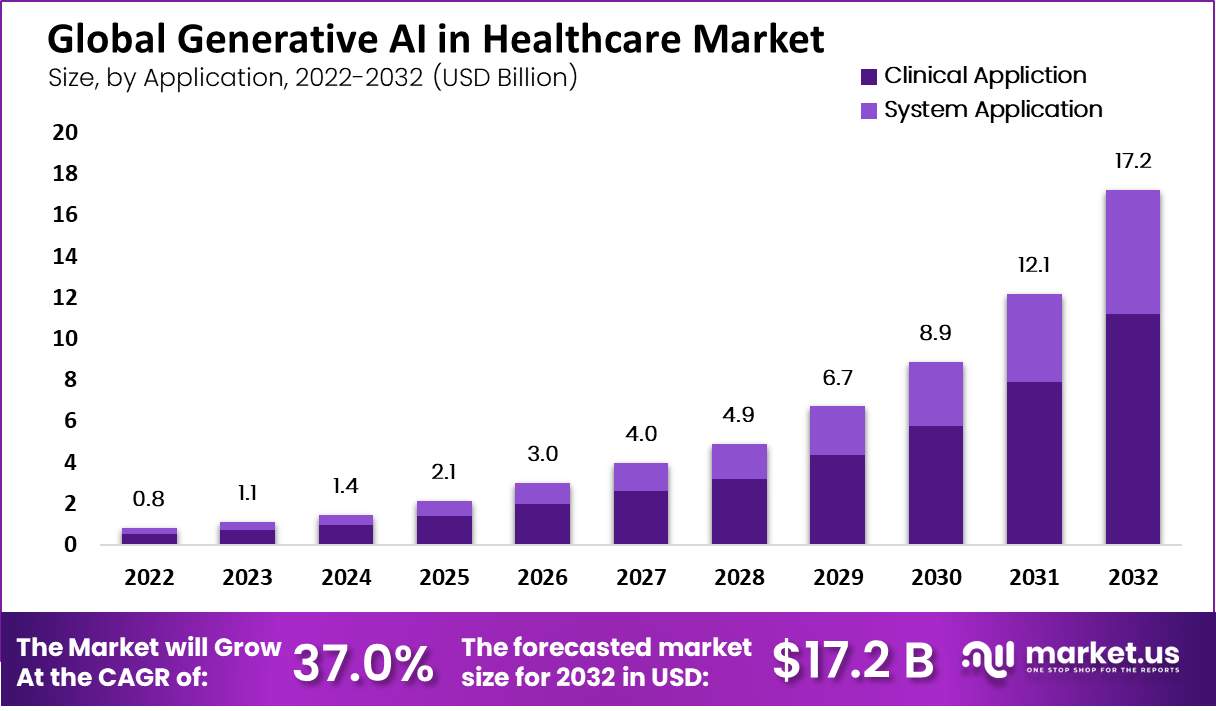
What is Medical Technology and Innovation?
Medical technology and innovation play a crucial role in advancing healthcare by improving patient outcomes, increasing efficiency, and enhancing the overall quality of care. From the development of life-saving devices to breakthroughs in digital health and precision medicine, the field of medical technology continues to evolve rapidly.
Adoption of Digital Health and Telemedicine: Key Statistics and Market Projections
Adoption of Digital Health
- The global Digital Health Market size is expected to be worth around USD 1,190.4 Billion by 2032 from USD 264.1 Billion in 2023, growing at a CAGR of 16.7% during the forecast period from 2023 to 2032.
- The US showed a 154% increase in telehealth usage in the first quarter of the year 2020.
- 76% of people over the age of 55 have used telemedicine.
- In the 2022 Survey, 80% of all respondents reported having accessed care via telemedicine at some point in their lives, up 8pp from 72% in 2021.
- 23.4 million U.S. patients utilized remote patient monitoring services and tools in 2022.
- By 2024, remote patient monitoring services and tools are expected to reach 30 million U.S. patients.
- 80% of Americans favor remote patient monitoring and more than one-half are strongly supportive of incorporating it into medical care services.
(Source: Willis Towers Watson, 2022, Rock Health)
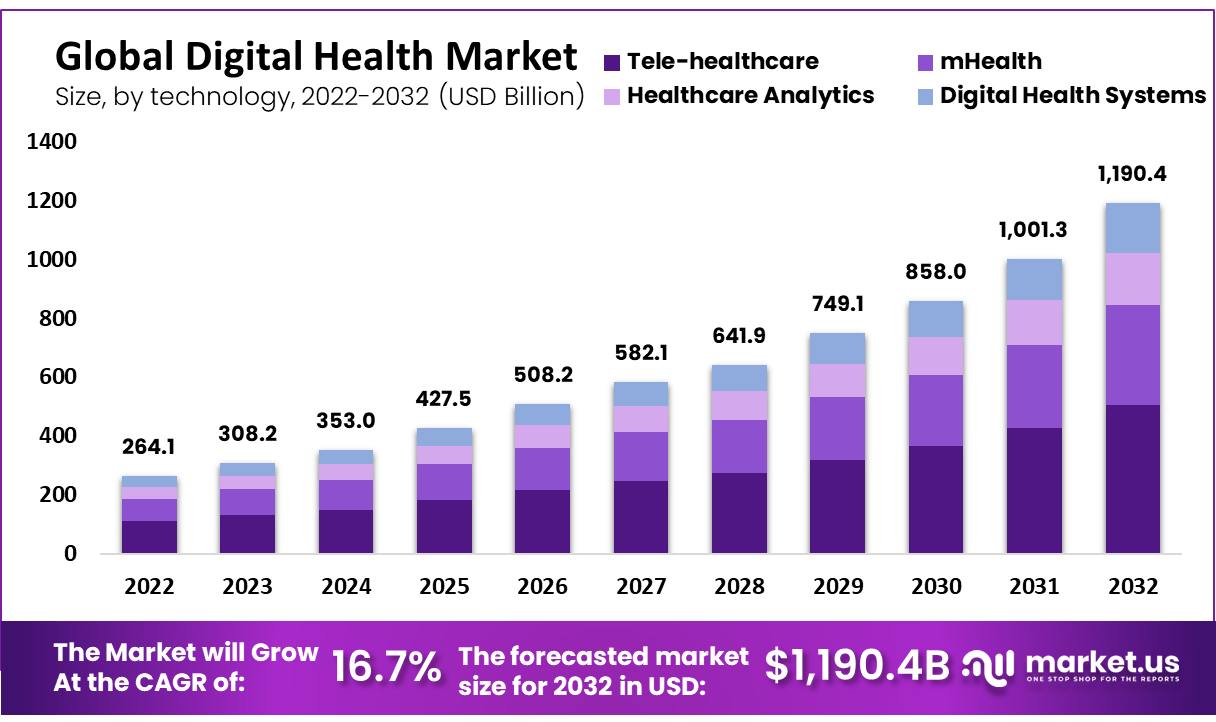
Adoption of Telemedicine
- The global telemedicine market size is expected to be worth around USD 590.9 Bn by 2032 from USD 63.5 Bn in 2022, growing at a CAGR of 25.7% during the forecast period from 2022 to 2032.
- The US showed a 154% increase in telehealth usage in the first quarter of the year 2020.
- About 2,720 million participants rated telemedicine in the COVID-19 pandemic.
- 70% of medical professionals rated telemedicine in the COVID-19 pandemic.
- Asia Pacific region showed a 52% increase in telehealth access to primary physicians/general patient services from 4% to 56%.
- Telehealth visits increased by 154% in the U.S. during the last week of March 2020 compared to the same period in 2019.
- The percentage of telehealth visits among Medicare primary care visits increased from 0.1% in February 2020 to 43.5% in April 2020.
- In a survey, 56% of physicians in the U.S. reported using telemedicine to provide care during the pandemic, compared to 18% before the outbreak.
- In a study, 76% of patients expressed interest in using telehealth to replace in-person visits, and 59% had a favorable impression of telehealth.
- The number of telehealth visits is projected to reach 1 billion by the end of 2020, with around 900 million visits attributed to the COVID-19 pandemic.
(Source: Willis Towers Watson, 2022, CDC, CMS, The Physicians Foundation, McKinsey & Company, Frost & Sullivan)
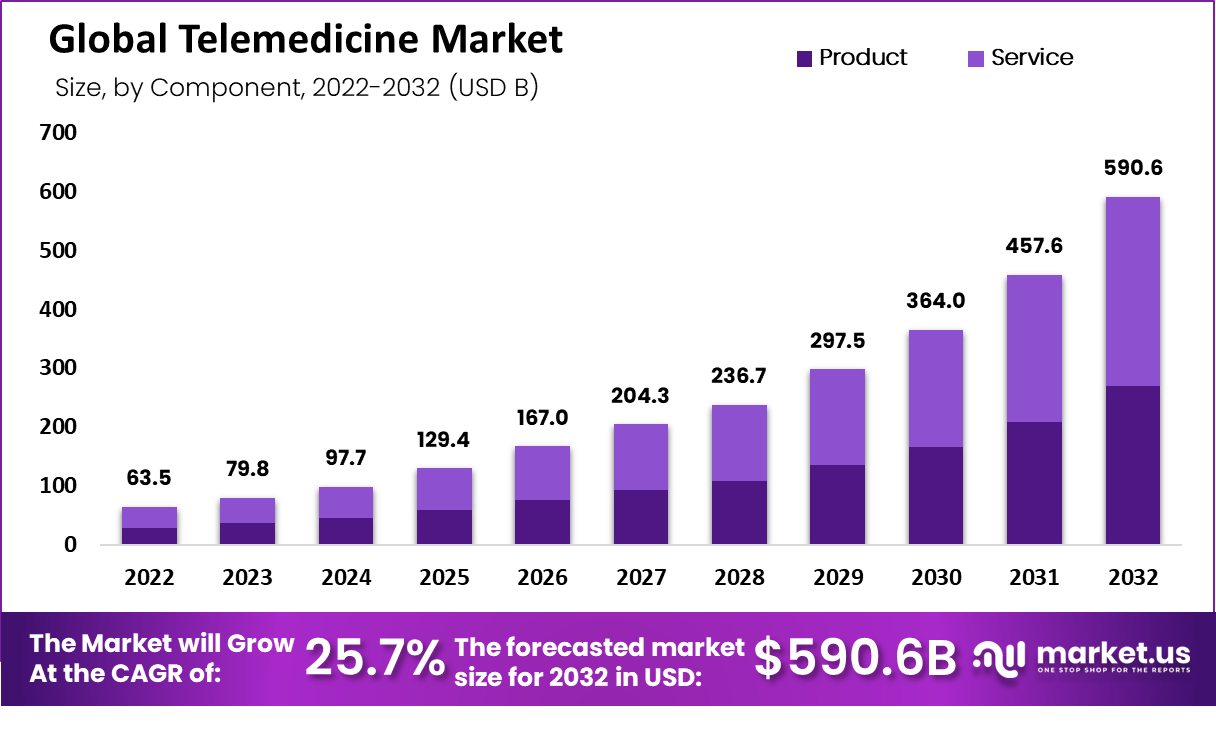
Artificial Intelligence (AI) in Healthcare
- According to market.us, the global artificial intelligence in the healthcare market was valued at USD 9.81 billion in 2022. It is projected to reach USD 238.5 billion at a CAGR of 38.73% between 2023 to 2032.
- About 45% of healthcare services worldwide adopted data integration software for their organizations.
- 36% of organizations implemented natural language processing software.
- North America is dominant in global AI in the healthcare market with the largest market share of 59.1%.
- By 2030, annual healthcare spending in the United States is expected to reach $6.8 trillion.
- The government share of this spending is projected to be 48% by 2030, driven by increases in Medicare enrolment, as more than 10,000 Americans become eligible for Medicare each day.
- 1.8% of organizations in the United States use machine learning in healthcare services.
- 1.3% of healthcare organizations use natural-language processing.
- In 2022, 12.6% of workers were employed at firms that utilize AI in healthcare.
- 51% of US adults who say ethnic biases in healthcare are a problem believe AI will reduce bias.
- According to market.us, the global artificial intelligence in drug discovery market was valued at USD 1.2 Billion in 2022. Between 2023 and 2032, this market is estimated to register the highest CAGR of 27.5%. It is expected to reach USD 12.8 Billion by 2032.
(Source: Statista, Market.us, FreeAgent CRM, Whitehouse)
Take advantage of our unbeatable offer - buy now!


Advancements in Medical Technology: Transforming Healthcare and Precision Medicine
- The global precision medicine market size is expected to be worth around USD 254 Bn by 2032 from USD 83.4 Bn in 2022, growing at a CAGR of 12.1% during the forecast period from 2022 to 2032.
- In 2020, the American Cancer Society reported approximately 606,520 cancer-related deaths in the US and 1.8 million new disease cases.
- The NCI created the Molecular Analysis for Therapy Choice project and directed approximately 6,000 clinical trials on precision medicine to treat cancer tumors.
- According to the National Cancer Institute, the annual rate of new cancer cases is 442.4 per 100,000 men and women. It accounts for 158.3 deaths per 100,000 men and women annually, affects an expected 16,850 adults and children between 0 and 19, and causes 1,730 deaths.
- Globally, biopharmaceutical companies spend USD 179 billion on R&D, according to the pharmaceutical industry and global health 2021 report, compared to the rest of the high-tech industry.
- According to the survey by Breastcancer.org, 31.7% of the 534 patients who were found to have breast cancer reported experiencing a significant delay in receiving treatment in July 2020.
- Furthermore, due to the COVID-19 pandemic in the United States, nearly 22% of these individuals reported a delay in screening, and 9.3% reported a delay in treatment.
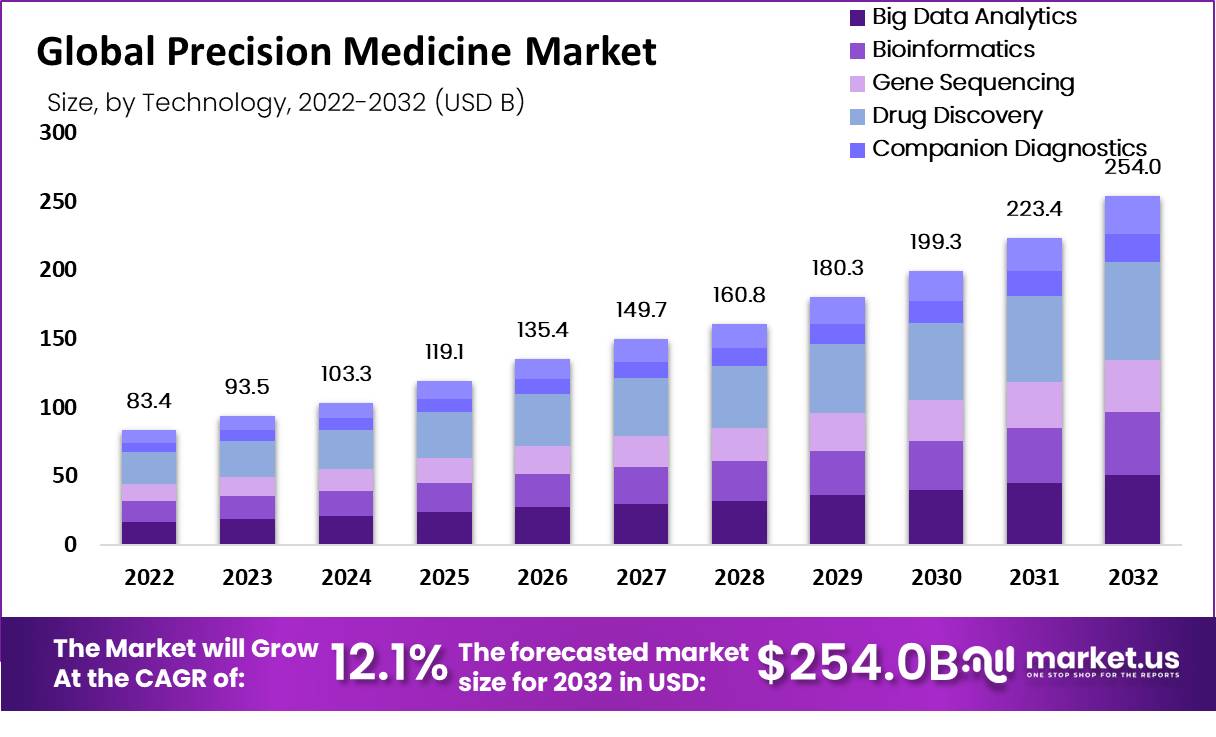
Adoption of Wearable Medical Devices
- The Global Wearable Medical Devices Market size is expected to be worth around USD 156.0 Billion by 2032 from USD 34.9 Billion in 2022, growing at a CAGR of 16.60% during the forecast period from 2023 to 2032.
- According to a study, wearable fitness trackers have shown promise in promoting physical activity and healthy behaviors, with a 28.4% increase in steps per day among participants who used wearable devices compared to those who did not.
- 86% of patients say that wearable healthcare technology devices improve health outcomes.
- wearable technology will flourish over the next 25 years, resulting in global cost savings of over $200 billion in the healthcare industry.
- wearable devices in use in 2020 were approximately 600 million.
(Source: JAMA Network Open, Software Advice Research, NIH)
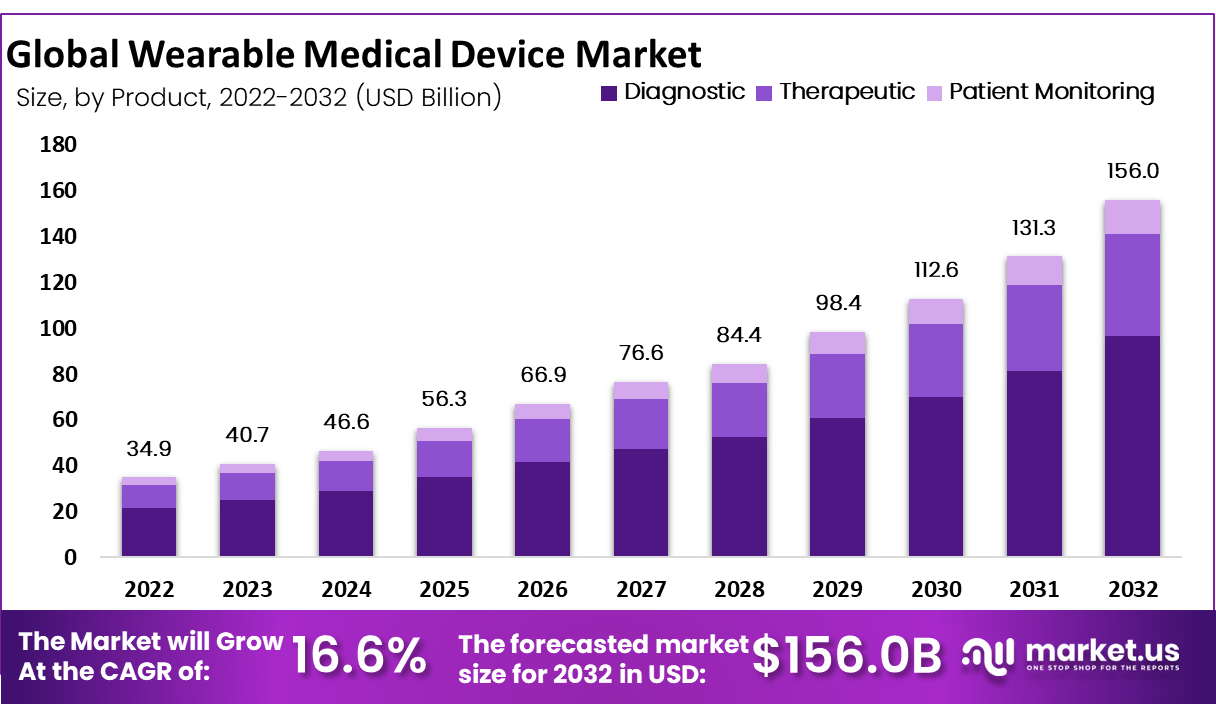
Robotics and Automation in Healthcare
- Robotic surgeries have increased to 15% of total surgical procedures despite limited evidence supporting them.
- The global market for robotic surgery systems was valued at $4.45 billion in 2020 and is projected to reach $11.45 billion by 2028, growing at a CAGR of 12.3% from 2021 to 2028.
- Intuitive Surgical’s da Vinci Surgical System is the world’s most-utilized robotic surgical system with over 5,000 installations worldwide.
- Robotic surgery has most extensively used in urology, with prostatectomy being one of the most common procedures performed using robotic surgery.
- Studies comparing robotic-assisted surgery and open surgery for colorectal cancer treatment found that patients undergoing robotic-assisted surgery experienced significantly fewer complications (14.1% vs 21.2%) and shorter hospital stays (6.7 vs 8.4 days).
- In 2022, the global surgical robotics market was valued at around USD 65 billion. By 2030, the market size was forecast to increase to nearly USD 119.7 billion.
(Source: Intuitive Surgical, European Association of Urology, Journal of the American Medical Association)
Adoption of Robotic Surgery by Hospitals
- Across 73 hospitals there was an increase in robotic surgery usage from 1.8% to 15.1% for all general surgery procedures.
- The use of robotic surgery increased by 2.1% per year.
- Hospitals saw an 8.8% increase in robotic surgery within the first four years of adopting the technology.
- The use of laparoscopic surgery decreased from 53.2% to 51.3% after adopting robotic surgery.
- In 2018, 753,000 robotic procedures were carried out across the US; these numbers climbed to 883,000 procedures performed in 2019 and then 876,000 procedures in 2020.
(Source: JAMA Network)

Innovations in 3D Bioprinting
- The global 3D bioprinting market size is expected to be worth around USD 6.9 billion by 2032 from USD 1.6 billion in 2022, growing at a CAGR of 16.1% during the forecast period from 2022 to 2032.
- Based on technology, the 3D bioprinting market is segmented into magnetic levitation bioprinting, laser-assisted bioprinting, and inkjet-based bioprinting. Inkjet-based bioprinting segment accounts for the largest share of revenue at 39.0% in 2022.
- North America dominated the 3D bioprinting market with the largest revenue share of 36.4% in 2022.
- In Asia Pacific, this market accounts for 28.0% of the revenue share of the 3D bioprinting industry in 2022 and is anticipated to maintain its dominance over the forecast period.
- The bioprinting of human organs and tissues is a rapidly advancing field. As of 2021, several organs and tissues have been successfully printed, including liver tissue, kidney tissue, heart tissue, skin, and blood vessels.
- The field of 3D bioprinting has seen increased investments and funding. In 2020, the US National Institute of Health announced a USD 6.5 million investment to establish a 3D printed tissue manufacturing program.

(Source: NIH, Advanced Materials, Market.us)
Medical Technology and Innovation – Biotechnology Innovations
- The number of approved gene therapies has been steadily increasing. As of September 2021, the U.S. Food and Drug Administration (FDA) has approved over 20 gene therapies for various diseases, including inherited disorders and certain types of cancer.
- The biotechnology industry is a major driver of job creation and economic growth. In the United States, the biotechnology sector employs over 1.8 million people, and in 2019, the industry contributed $1.3 trillion to the country’s economic output.
- The global biopharmaceuticals market size is expected to be worth around USD 566 billion by 2032 from USD 263 billion in 2022, growing at a CAGR of 8.2% during the forecast period from 2022 to 2032.
- The global gene therapy market size is expected to be worth around USD 49.3 Bn by 2032 from USD 5.6 Bn in 2022, growing at a CAGR of 25% during the forecast period from 2022 to 2032.
- Ethics and policy in CRISPR have gained significant traction with more than 50 countries across the globe implementing guidelines and regulations to address ethical concerns.
(Source: FDA, Biotechnology Innovation Organization)

Medical Technology and Innovation: Key Statistics in Top Countries
United States
- The United States is the largest medical technology market globally, accounting for approximately 40% of the global market share.
- In 2020, the medical technology industry in the U.S. invested around $15 billion in research and development.
- The U.S. is a leader in the development and adoption of digital health technologies, with telemedicine visits reaching a peak of over 1.7 billion in 2020.
(Source: The Advanced Medical Technology Association – AdvaMed, McKinsey & Company)
Germany
- Germany is one of the largest medical technology markets in Europe and ranks among the top three globally.
- The medical technology industry in Germany employs over 215,000 people.
- Germany is known for its strong research and development activities, with companies investing over €4 billion annually.
(Source: German Medical Technology Association – BVMed)
Japan
- Japan has a significant medical technology market and is known for its advanced healthcare infrastructure and technological innovations.
- The medical technology industry in Japan is driven by major players like Hitachi, Toshiba, and Olympus.
- Japan has been actively embracing digital health technologies, including telemedicine and health monitoring devices.
(Source: Japan Medical Devices Manufacturers Association – JMED)
China
- China has emerged as a major player in the medical technology market. With rapid growth and increasing investments in research and development.
- The medical technology market in China is expected to reach approximately $225 billion by 2025.
- The Chinese government has been promoting the development and adoption of digital health technologies and telemedicine to improve healthcare accessibility.
(Source: Deloitte)
United Kingdom
- The United Kingdom has a thriving medical technology sector, with a focus on innovation and research.
- The medical technology industry in the UK employs over 100,000 people and contributes significantly to the country’s economy.
- The UK has been investing in digital health initiatives, including the establishment of digital innovation hubs and the implementation of telehealth programs.
(Source: MedTech Europe, National Health Service – NHS)
Recent Developments
Mergers and Acquisitions:
- In 2021, Siemens Healthineers completed the acquisition of Varian Medical Systems, a leading provider of cancer care solutions, for approximately $16.4 billion.
- This strategic move enhances Siemens’ capabilities in oncology and strengthens its position in the global medical technology market.
New Product Launches:
- In 2022, Medtronic launched the Hugo™ robotic-assisted surgery system, offering enhanced capabilities for minimally invasive surgeries.
- This advanced surgical platform incorporates artificial intelligence and machine learning technologies to improve surgical precision and patient outcomes.
Funding and Investments:
- The medical technology sector witnessed significant investment activity in recent years. In 2021, digital health startups raised a record-breaking $29.1 billion in funding globally.
- This funding supports the development of innovative healthcare technologies, including wearable devices, telemedicine platforms, and digital therapeutics.
Partnerships and Collaborations:
- In 2020, Philips partnered with Augusta University Health in the United States to establish a state-of-the-art tele-ICU (intensive care unit) program.
- This collaboration combines Philips’ telehealth technology with Augusta University Health’s expertise to improve patient care outcomes and enhance critical care delivery remotely.
Regulatory Approvals and Clinical Trials:
- Recent years have seen an increase in regulatory approvals for medical devices and therapies. For example, in 2021, the FDA approved the use of the ReWalk ReStore™ Exo-Suit for stroke rehabilitation.
- This innovative device assists patients in regaining mobility and independence during the recovery process.
Key Takeaways
Medical technology and innovation continue to revolutionize the healthcare industry, driving advancements in diagnosis, treatment, and patient care.
From the development of cutting-edge devices and precision medicine to the application of artificial intelligence and big data analytics, these advancements have the potential to improve patient outcomes, increase efficiency, and reduce healthcare costs.
As technology continues to evolve, healthcare professionals, policymakers, and researchers must collaborate and harness its power to ensure its widespread adoption and maximum benefit to society.
With the continued focus on research, development, and implementation, medical technology and innovation have the potential to transform healthcare and enhance the overall well-being of individuals worldwide.
FAQs
Medical technology refers to the use of scientific and technological innovations to improve healthcare and medical treatments. It encompasses a wide range of tools, devices, equipment, and procedures used in the prevention, diagnosis, treatment, and management of diseases and medical conditions.
Recent innovations in medical technology include advancements in areas such as telemedicine and remote patient monitoring, wearable health devices, artificial intelligence (AI) and machine learning applications in healthcare, robotics-assisted surgery, personalized medicine, gene editing technologies like CRISPR, 3D printing of medical devices and organs, and the development of targeted therapies and immunotherapies for various diseases.
As of 2021, the global medical technology market was valued at approximately $456 billion. It is expected to grow at a compound annual growth rate (CAGR) of 4.9% from 2021 to 2028.
The United States is the largest spender in medical technology and innovation. In 2020, the U.S. healthcare sector invested over $100 billion in medical technology research and development.
The use of telemedicine has significantly increased in recent years. In 2020, about 76% of U.S. hospitals were using telehealth technology, compared to just 35% in 2010.
Discuss your needs with our analyst
Please share your requirements with more details so our analyst can check if they can solve your problem(s)



